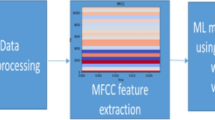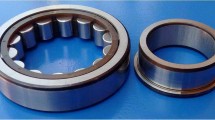Abstract
Rolling element bearings are the critical mechanical components in industrial applications. These rotary elements work continuously under different operating and environmental conditions. It leads to generation of various defects over the operating surfaces of bearing components. In this study, four machine learning techniques, two ensemble techniques, i.e., rotation forest and random subspace, and two well-established techniques, i.e., support vector machine and artificial neural network, are utilized for fault severity classification. Time domain, frequency domain and wavelet-based features are extracted from the raw vibration signals of rolling element bearings for the investigations. Four feature ranking techniques are employed to rank extracted features. Comparative study is carried out among the machine learning techniques with and without the ranking of features. Present study not only investigates various machine learning techniques but also examines the performance of various feature ranking techniques for fault severity classification of rolling element bearings. Results show that ensemble techniques have superior classification efficiency and take very less computational time for the analysis in comparison to support vector machine and artificial neural network.












Similar content being viewed by others
References
Singh GK, Al Kazzaz SAS (2003) Induction machine drive condition monitoring and diagnostic research—a survey. Electr Power Syst Res 64:145–158
Sharma A, Amarnath M, Kankar PK (2016) Feature extraction and fault severity classification in ball bearings. J Vib Control 22:176–192
Kankar PK, Sharma SC, Harsha SP (2011) Rolling element bearing fault diagnosis using wavelet transform. Neurocomputing 74:1638–1645
Samanta B, Al-Balushi KR, Al-Araimi SA (2003) Artificial neural networks and support vector machines with genetic algorithm for bearing fault detection. Eng Appl Artif Intel 16:657–665
Singh S, Kumar N (2014) Combined rotor fault diagnosis in rotating machinery using empirical mode decomposition. J Mech Sci Technol 28:4869–4876
Li B, Chow M-Y, Tipsuwan Y, Hung JC (2000) Neural-network-based motor rolling bearing fault diagnosis. IEEE Trans Ind Electron 47:1060–1069
Sugumaran V, Ramachandran KI (2011) Effect of number of features on classification of roller bearing faults using SVM and PSVM. Expert Syst Appl 38:4088–4096
Guo H, Jack LB, Nandi AK (2005) Feature generation using genetic programming with application to fault classification. IEEE Trans Syst Man Cybern B 35:89–99
Wu S-D, Wu P-H, Wu C-W, Ding J-J, Wang C-C (2012) Bearing fault diagnosis based on multiscale permutation entropy and support vector machine. Entropy 14:1343–1356
Vakharia V, Gupta VK, Kankar PK (2015) A multiscale permutation entropy based approach to select wavelet for fault diagnosis of ball bearings. J Vib Control 21:3123–3131
Wang Y, Kang S, Jiang Y, Yang G, Song L, Mikulovich VI (2012) Classification of fault location and the degree of performance degradation of a rolling bearing based on an improved hyper-sphere-structured multi-class support vector machine. Mech Syst Signal Process 29:404–414
Abbasion S, Rafsanjani A, Farshidianfar A, Irani N (2007) Rolling element bearings multi-fault classification based on the wavelet denoising and support vector machine. Mech Syst Signal Process 21:2933–2945
Zhang Y, Zuo H, Bai F (2013) Classification of fault location and performance degradation of a roller bearing. Measurement 46:1178–1189
Zarei J, Tajeddini MA, Karimi HR (2014) Vibration analysis for bearing fault detection and classification using an intelligent filter. Mechatronics 24:151–157
Liu Z, Cao H, Chen X, He Z, Shen Z (2013) Multi-fault classification based on wavelet SVM with PSO algorithm to analyze vibration signals from rolling element bearings. Neurocomputing 99:399–410
Wen W, Fan Z, Karg D, Cheng W (2015) Rolling element bearing fault diagnosis based on multiscale general fractal features. Shock Vib 2015:1–9
Zhao Z, Morstatter F, Sharma S, Alelyani S, Anand A, Liu H (2010) Advancing feature selection research—ASU feature selection repository. Technical Report, Arizona State University, 1–28 (accessed in Dec. 2015)
Samanta B, Al-Balushi KR, Al-Araimi SA (2006) Artificial neural networks and genetic algorithm for bearing fault detection. Soft Comput 10:264–271
Kappaganthu K, Nataraj C (2011) Feature selection for fault detection in rolling element bearings using mutual information. J Vib Acoust 133:061001–061012
Sugumaran V, Muralidharan V, Ramachandran KI (2007) Feature selection using decision tree and classification through proximal support vector machine for fault diagnostics of roller bearing. Mech Syst Signal Process 21:930–942
Malhi A, Gao RX (2004) PCA-based feature selection scheme for machine defect classification. IEEE Trans Instrum Meas 53:1517–1525
Bearing vibration data set, Case Western Reserve University bearing data centre website. Available at: http://csegroups.case.edu/bearingdatacenter/pages/welcome-case-western-reserve-university-bearing-data-center-website. Accessed in Dec 2015
Karabulut EM, Ibrikçi T (2012) Effective diagnosis of coronary artery disease using the rotation forest ensemble method. J Med Syst 36:3011–3018
Kavzoglu T, Colkesen I (2013) An assessment of the effectiveness of a rotation forest ensemble for land-use and land-cover mapping. Int J Remote Sens 34:4224–4241
Kuncheva LI, Rodríguez JJ (2007) An experimental study on rotation forest ensembles. In: Proceedings of the 7th international conference on multiple classifier systems (MCS’07), Springer, Prague, Czech Republic, pp 459–468
Rodríguez JJ, Kuncheva LI (2006) Rotation forest: a new classifier ensemble method. IEEE Trans Pattern Anal 28:1619–1630
Ho TK (1998) The random subspace method for constructing decision forests. IEEE Trans Pattern Anal 20:832–844
Witten IH, Frank E (2005) Data mining: practical machine learning tools and techniques. Morgan Kaufmann, San Francisco
Widodo A, Yang B-S (2007) Support vector machine in machine condition monitoring and fault diagnosis. Mech Syst Signal Process 21:2560–2574
Altidor W, Khoshgoftaar TM, Hulse JV (2011) Robustness of filter-based feature ranking: a case study. In: Proceedings of the twenty-fourth international Florida artificial intelligence research society conference, pp 453–458
Samanta B, Al-Balushi KR, Al-Araimi SA (2004) Bearing fault detection using artificial neural networks and genetic algorithm. EURASIP J Appl Signal Process 3:366–377
Saxena A, Celaya J, Balaban E, Goebel K, Saha B, Saha S, Schwabacher M (2008) Metrics for evaluating performance of prognostics techniques. In: Proceedings of the international conference on prognostics and health management (PHM08), pp 1–17
Saxena A, Saad A (2007) Evolving an artificial neural network classifier for condition monitoring of rotating mechanical systems. Appl Soft Comput 7:441–454
Acknowledgments
The authors are thankful to Prof. KA Loparo and Case Western Reserve University for providing open access to bearing dataset.
Author information
Authors and Affiliations
Corresponding author
Additional information
Technical Editor: Kátia Lucchesi Cavalca Dedin.
Rights and permissions
About this article
Cite this article
Sharma, A., Amarnath, M. & Kankar, P.K. Novel ensemble techniques for classification of rolling element bearing faults. J Braz. Soc. Mech. Sci. Eng. 39, 709–724 (2017). https://doi.org/10.1007/s40430-016-0540-8
Received:
Accepted:
Published:
Issue Date:
DOI: https://doi.org/10.1007/s40430-016-0540-8




